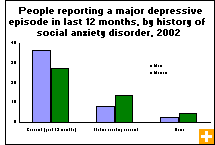Common menu bar links
Social anxiety disorder
Archived Content
Information identified as archived is provided for reference, research or recordkeeping purposes. It is not subject to the Government of Canada Web Standards and has not been altered or updated since it was archived. Please contact us to request a format other than those available.
Most of us have felt awkward or embarrassed in a social or performance situation at some point in our lives. However, some of us suffer from social anxiety disorder (also known as social phobia) and go through life with a 'crippling shyness'.
According to the 2002 Canadian Community Health Survey (CCHS), just over two million Canadians aged 15 or older have experienced social anxiety disorder at some point in their lives. Approximately 750,000 people experienced symptoms in the 12 months before the survey interview.
 Symptoms
of the disorder typically appear in childhood or early adolescence and can
persist for years. Women are more likely than men to experience the disorder,
and people aged 15 to 24 are more likely to have current social anxiety disorder
than the middle-aged or seniors.
Symptoms
of the disorder typically appear in childhood or early adolescence and can
persist for years. Women are more likely than men to experience the disorder,
and people aged 15 to 24 are more likely to have current social anxiety disorder
than the middle-aged or seniors.
The CCHS data point to a relationship between social anxiety disorder and lower educational attainment, reduced employment opportunities, low income, dependence on welfare or social assistance, decreased likelihood of marriage or of having a successful marriage, and social isolation. The disorder is also associated with higher rates of disability, rather negative perceptions of physical and mental health, and dissatisfaction with life.
Substantial evidence indicates that this 'illness of lost opportunities' is linked to increased risk of other anxiety, mood, and substance abuse disorders, and may be associated with their severity and persistence. Finally, social anxiety disorder often precedes other mental disorders, as found in many other studies.
Although treatment is available, most people with social anxiety disorder do not seek professional help to deal with their fears, often because of a fear of seeking out assistance or because of a failure to recognize the disorder for what it is.


